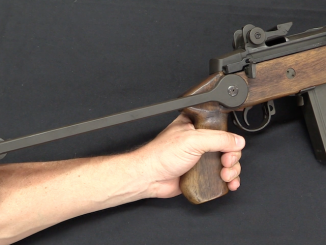This is Lot #1230 in the upcoming December 2020 RIA Premier auction.
The Model 1899 was the last pattern of the Remington Lee Military Rifle, following the models of 1879, 1882, and 1885. In this final guise, it was redesigned to handle new smokeless powder ammunition, with a new detachable bolt head that included two additional locking lugs. Only a few thousand were made, between 2,000 for the Michigan National Guard, 3,000 for the Cuban Rural Guard, and about 1,500 commercial production models (primarily porter and military patterns, with only a tiny number of carbines). The vast majority were chambered for .30 U.S.A. (aka .30-40), although it was also offered in 7mm Mauser, 7.65mm Mauser, .303 British, and 6mm Lee Navy.




“1,500 commercial production models (primarily porter and military patterns, with only a tiny number of carbines)”
What is porter pattern?
I’d guess it’s a typo for “sporter”.
Daweo,
Believe that is a typographical error – should be “sporter” as in a sporterized pattern. Regards.
The ‘separate’ bolt head is similar to Lebel and Berthier bolt design.
The Mills ‘web-gear’, as used by the Michigan N.G., had four pockets for loaded magazines, as well as, individual cartridge loops. The concept was to use the rifle as a ‘single-shot’.
When required, magazines were inserted, on command, to provide 20 rounds of ‘rapid-fire’.
Michigan N.G. rifles were replaced around 1904 by U.S. Krag-Jorgensen. The rifle’s weak points had soon been discovered and made it unpopular with the M.N.G.
The Model 1899 Remington-Lee rifles were given to Michigan Naval Reserves. They were used as ‘drill rifles’ during WW1.
During WW2, the ‘Michigan Remington-Lee rifles’ were used as ‘drill rifles’ by the Michigan State Police.
In the ‘drill rifle’ role, the bolts and magazines were dispensed with. This has lead to mismatched or missing bolts and missing magazines.
IMHO – Ian’s video is quite good and accurately identifies the model 1899 Remington-Lee rifle’s weaknesses.
The worst vice was probably the lack of provision for a ‘recoil lug’. Most model 1899 stocks have a split or crack to the left-rear of the action.
The British made a good concept into a great rifle, refining a black powder design.
The more modern, ‘front locking-lug’, smokeless model 1899 suffered from not undergoing a period of testing and improvement.
It is still a sweet looking rifle!
Hi Ian,
Thanks for the video on the Remington Lee 1899. I have one that I inherited from my Great Uncle. It was sporterized before he bought it in Newberry, Michigan in 1927? The person that did the sporter job was a craftsman. The crown on the muzzle is perfect and the ramrod hole is nearly impossible to detect. The serial number is 100,457 which would indicate that it was a Michigan National guard rifle. I have found several other sporterized Michigan rifles and they appear to be done by the same gunsmith. Is there any information on how Michigan disposed of them?
Keep up the great work.
Hello Jim,
I have serial number 100,895. Was my fathers deer rifle. His older brother found it for him probably around 1950/51. Also a sporterized version. I sure would love to find and extra magazine or two.
Now knowing the rifles heritage, I just found serial 100,483 for sale on Gunbroker.
What caliber were the Cuban contract guns?
.30 Government aka .30-40 Krag. In 1914, the French government purchased 1,150 1899s from Remington. They had been returned to the manufacturer after the Cuban Guardia Rurales had been re-equipped with Krag-Jorgensons.
The French Army issued these Remington-Lees and an assortment of other rifles to auxiliary, support, and colonial troops to allow the frontline troops to have the Modele’ 1886 Lebels and, later, the Modele’ 1916 Berthier with its five-round magazine.
Strictly speaking, the M1899 was superior to their two “indigenous” frontline rifles, being in design terms fundamentally an intermediate step between the original “Long” Lee-Enfield and the SMLE.
See; “French Rifles of World War 1, Parts 1 and 2” by Paul Scarlata, Shotgun News Treasury XV, 2015, pp.162-174.
cheers
eon
Thank you, eon, for the article reference.
the Guardia Rural has an incredibly detailed marksmanship manual for both rifles and revolvers dated 1909, and written by Captain Frank Parker.
The Remington-Lee bolt-action rifles in .30-40 were adopted in 1905. After the first U.S. occupation of Cuba ended in 1902, the Rural Guard primarily had .43 Spanish or .43 reformado Remington rolling blocks, and 7x57mm Mauser carbines or rifles. The first arms purchased from Remington were apparently Remington Model 1902 rolling blocks in 7x57mm, confusingly referred to as “Remington-Mauser” rifles because of the “calibre fino” or 7mm cartridge. By 1906, there was considerable political violence surrounding the elections, which caused the second U.S. occupation. The Guardia Rural by then had the Remington-Lee bolt action rifles in .30-40, a number of Krag-Jørgensen carbines on order, many .44 Winchester lever-actions, and 7mm rolling blocks. The Guardia Rural was supplemented by militia groups, armed with as many as seven different kinds of rifles. By 1909 the withdrawing U.S. forces set up the Ejército Permanente, which was one of the few nations to officially adopt the U.S. Model 1903 Springfield “Roosevelt Mauser” as the standard service rifle. When the U.S. first withdrew from Cuba, the idea was that wealthy sugar mill owners would supply the Guardia Rural as a gendarmerie, and a regiment of coastal artillery in Havana would suffice until the U.S. Navy intervened. By 1909, the idea was to create a powerful and politically reliable army for internal defense, which resulted in the 1933 sergeants’ revolt, and by March 1952, the Fulgencio Batista Zaldívar “Batistato.”
Apparently, there are reports claiming that 1920s-era Bannerman catalogues had .30-40 Model 1895 Winchester lever actions from a purported/ rumored “Cuban contract” but I’m not aware of any details.
Well! Good to hear about it.
Thanks For Sharing Such An Interesting Article, It Is Really Worthy To Read. I Have Subscribed To You And From Now On I’ll Check Your Profile Daily For Interesting pieces of Stuff.
That’s is really very nice post its all information is really helpful.
redesigned to handle new smokeless powder ammunition, with a new detachable bolt head that included two additional locking lugs.
it seems like this would have been a nightmare to headspace with the bolthead held on like that. completely removed the length advantage of a rear locking bolt too.